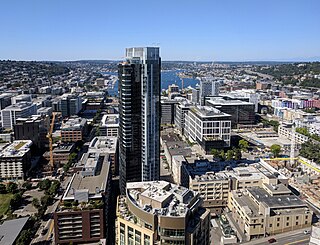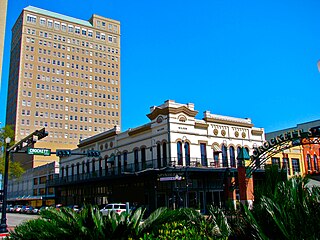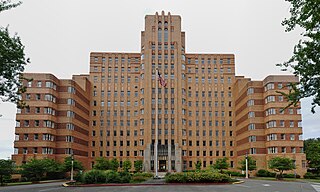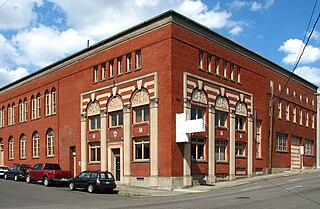
Pioneer Square is a neighborhood in the southwest corner of Downtown Seattle, Washington, US. It was once the heart of the city: Seattle's founders settled there in 1852, following a brief six-month settlement at Alki Point on the far side of Elliott Bay. The early structures in the neighborhood were mostly wooden, and nearly all burned in the Great Seattle Fire of 1889. By the end of 1890, dozens of brick and stone buildings had been erected in their stead; to this day, the architectural character of the neighborhood derives from these late 19th century buildings, mostly examples of Richardsonian Romanesque.

South Lake Union is a neighborhood in Seattle, Washington, so named because it is at the southern tip of Lake Union.

Bebb and Gould was an American architectural partnership active in Seattle, Washington from 1914 to 1939. Partners Charles Herbert Bebb and Carl Freylinghausen Gould were jointly responsible for the construction of many buildings on the University of Washington's Seattle campus, as well as the Seattle Times Square Building (1914), Everett Public Library, U.S. Marine Hospital, and the Seattle Art Museum building in Volunteer Park.

The Sanitary Laundry Company Building is a historic building located at Baltimore, Maryland, United States. It is a five-bay wide, five-story brick loft building constructed in 1883. The façade features a cast-iron storefront at street level and the elaborate decorative brickwork and terra cotta ornamentation on the upper floors reflect the influence of the Queen Anne style. It was built originally as a slaughterhouse and meat packing plant until 1897, when it was converted to a commercial laundry.

The Beaumont Commercial District is located in Downtown Beaumont, Texas. The district consists of various styles of buildings, including 6 highrises built before 1932. The district is registered on the National Register of Historic Places as a U.S. Historic District. The historic district is roughly bounded by Willow, Neches, Gilbert and Main Streets. The Old Spanish Trail travels through Downtown on Willow, Park, Pearl and College Streets.

Washington Hall is a historic building and a registered city landmark in Seattle, Washington, that is listed on the National Register of Historic Places. It was originally built as a community center by the Danish Brotherhood in America, a fraternal organization, with meeting halls and one-room apartments for new immigrants. In 1973, the building was sold to the Sons of Haiti who leased the space to various tenants. It was purchased in 2009 by Historic Seattle and was renovated and re-opened in 2010 as an events and performance space.

The Holyoke Building is a historic building located in downtown Seattle, Washington. It is a substantial five story brick structure with stone trimmings. Construction began at the corner of First Avenue and Spring Streets just before the Great Seattle fire of 1889. Completed in early 1890, it was among the first permanent buildings completed and ready for occupancy in downtown Seattle following the fire. Today the Holyoke Building is one of the very few such buildings still standing in Seattle outside of the Pioneer Square district and is a historic remnant of the northward expansion of Seattle's business district between the time of the great fire and the Yukon Gold Rush in 1897.

The Globe Building, Beebe Building and the Hotel Cecil are a trio of historic office/hotel buildings located in Downtown Seattle, Washington, United States. The buildings occupy the entire west side of the 1000 block of 1st Avenue between Madison and Spring streets. The three buildings were constructed from late 1900 to 1901 for Syracuse-based investors Clifford Beebe and William Nottingham by the Clise Investment Company, headed by businessman James Clise (1855–1938), as a result of the Alaska Gold Rush which fueled the construction of many such buildings in downtown Seattle.

The National Building is a historic warehouse building in downtown Seattle, Washington, located on the east side of Western Avenue between Spring and Madison Streets in what was historically Seattle's commission district. It is now home to the Seattle Weekly. It is a six-story plus basement brick building that covers the entire half-block. The dark red brick facade is simply decorated with piers capped with small Ionic capitals and a small cornice, which is a reproduction of the original cornice. Kingsley & Anderson of Seattle were the architects.

The Pacific Tower, formerly the Pacific Medical Center, is a 16-story building at 1200 12th Avenue South on Beacon Hill in Seattle, Washington, United States. It was completed in 1932 and opened the following year as a U.S. Public Health Service facility. The lower floors of the facility still function as a medical center today. Amazon.com occupied much of the building as its headquarters from 1999 until 2010. Much of the space was left vacant after Amazon relocated to South Lake Union. In 2013, the state of Washington agreed to a 30-year lease of 13 floors. Seattle Central College subleases six floors for its healthcare training program.

The Yale Union Laundry Building, also known as the Yale Laundry Building, the City Linen Supply Co. Building, Perfect Fit Manufacturing and simply Yale Union (YU), in southeast Portland, Oregon, is a two-story commercial structure listed on the National Register of Historic Places. Built largely of brick in 1908, and embellished with Italian Revival and Egyptian Revival decorations, it was added to the register in 2007. Two-story additions in 1927 and 1929 changed the original building into an L-shaped structure that shares a party wall with a building to the east.

The Bergmann Hotel is a historic hotel located at 434 3rd Street in Juneau, Alaska. It is listed on the National Register of Historic Places.

Issaquah station, also known as Issaquah Depot or the Seattle, Lake Shore and Eastern Railway Depot, is a former railway station located in Issaquah, Washington, listed on the National Register of Historic Places. It was built in 1889 as a passenger station and freight warehouse for the Seattle, Lake Shore and Eastern Railway (SLS&E), serving what was then known as Gilman, Washington. The town was renamed Issaquah around the turn of the century. Only a few years after the depot's opening, in the 1890s, the SLS&E was taken over by the Northern Pacific Railway.

The Monte Cristo Hotel is a historic building located in Everett, Washington. It is a major feature of the city's downtown core. It ceased functioning as a hotel in 1972. It was listed on the National Register of Historic Places on June 3, 1976. In 1994 it was restored and redeveloped into low income housing.

Fire Station No. 23 is a former fire station located in the Central District of Seattle, Washington listed on the National Register of Historic Places. It was remodeled as the Cherry Hill Community Center in 1970, and served as the headquarters of Centerstone. It was again renamed in 2018 to Byrd Barr Place. This was done to honor local US civil rights leader Roberta Byrd Barr, who is cited as strong supporter of CAMP's efforts since the 1960s. The location currently offers community support to the surrounding Seattle area, including housing assistance, tackling food insecurity, and bringing the community together to advocate for its needs. Byrd Bard Place seeks to support Black Washingtonian's within Seattle's Central District in particular, with the end goal of bettering the state of Washington collectively.

The Hull Building is a historic commercial building located at 2401-2405 1st Avenue in the Belltown neighborhood of Seattle, Washington. Designed by notable Northwest architect Elmer Fisher, It was constructed in the latter half of 1889 as an investment property by Seattle politician Alonzo Hull (1843-1929), and was added to the National Register of Historic Places on January 27, 1983. It is adjacent to the Battery Street Tunnel's south portal.

The Harry Vanderbilt Wurdemann House, also known as the Wurdemann House, is a private home in Lake Forest Park, Washington. Built in 1914 and listed in the National Register of Historic Places in 1990, it was one of the first houses in Lake Forest Park.

Abraham Horace Albertson was an American architect who was one of Seattle, Washington's most prominent architects of the first half of the 20th century. He was born in New Jersey and educated at Columbia University in New York. Early in his career, he moved to Seattle in the employ of a well-known New York architectural firm with that was developing a large area in downtown. He worked on many projects in Seattle from around 1910 through the 20s and early 30s. Some of his designs are Seattle landmarks and/or listed on the National Register of Historic Places.

The Portland New Chinatown/Japantown Historic District is a historic district in Portland, Oregon's Old Town Chinatown neighborhood, in the United States. The district is listed on the National Register of Historic Places.






















